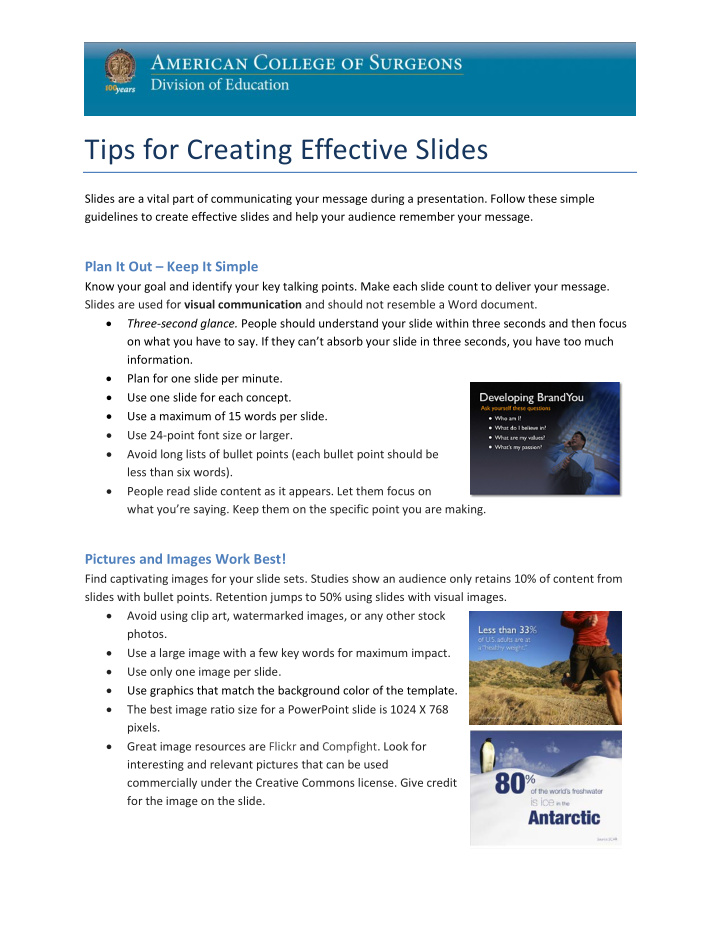



Tips for Creating Effective Slides Slides are a vital part of communicating your message during a presentation. Follow these simple guidelines to create effective slides and help your audience remember your message. Plan It Out – Keep It Simple Know your goal and identify your key talking points. Make each slide count to deliver your message. Slides are used for visual communication and should not resemble a Word document. • Three-second glance. People should understand your slide within three seconds and then focus on what you have to say. If they can’t absorb your slide in three seconds, you have too much information. • Plan for one slide per minute. • Use one slide for each concept. • Use a maximum of 15 words per slide. • Use 24-point font size or larger. • Avoid long lists of bullet points (each bullet point should be less than six words). • People read slide content as it appears. Let them focus on what you’re saying. Keep them on the specific point you are making. Pictures and Images Work Best! Find captivating images for your slide sets. Studies show an audience only retains 10% of content from slides with bullet points. Retention jumps to 50% using slides with visual images. • Avoid using clip art, watermarked images, or any other stock photos. • Use a large image with a few key words for maximum impact. • Use only one image per slide. • Use graphics that match the background color of the template. • The best image ratio size for a PowerPoint slide is 1024 X 768 pixels. • Great image resources are Flickr and Compfight. Look for interesting and relevant pictures that can be used commercially under the Creative Commons license. Give credit for the image on the slide.
Don’t Overdo It Audiences judge presentations on their interest in the content, not on how many fancy features are used in the slides. • Use white space effectively. • Use high contrast with color. • Use animation, bold slide transitions, and video sparingly. • For video, use short clips that can be absorbed quickly. • Use phrases or abbreviated sentences rather than full sentences. • Limit and repeat the same fonts, colors, and shapes for styling consistency, typically choosing between one and three of each. • Play with typography to create impact, interest, and hierarchy. Display Data Clearly Your presentation data needs to be displayed clearly for your audience to grasp the information within a few seconds. Choose simple ways to visualize your data. • Use graphs and charts and incorporate bold contrasts to highlight the most important data points. • Find the most recent and relevant data for your presentation from authoritative sources. • Always cite your references to give your presentation more credibility. • Highlight the most important information in tables and graphs. If needed, use builds to present data in a series of bite-sizes pieces. Tables • Do not use a table if the same information can be presented as a short sentence, a piece of art, or as a graph or chart. • Keep tables simple by including only the data you will need to discuss. • Compare similar elements. For example, compare demographics (gender, age, race, etc.) in one table and compare operative findings in another. • Limit tables to four columns and seven rows. Break larger tables into multiple slides. • Compare numbers in columns, not rows. • Round numbers if necessary. Zero and 100 do not need decimal places. • Use footnotes to eliminate distracting data from your table. • Include a legend for acronyms.
Don’t Forget Your Audience It's not a race! Remember who your presentation is for: your audience. You don't need to speed through your slides. • Don’t read your slides! • Focus on the balance of storytelling as you narrate through the visuals and message of your slide. • Engage your listeners. • Practice makes perfect. Spend time tweaking your presentation as you go through some trial runs to work out your timing and delivery.
Recommend
More recommend